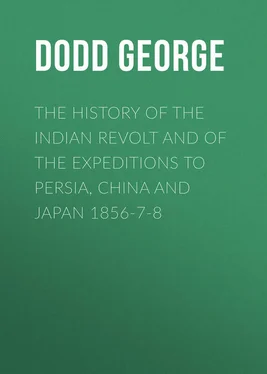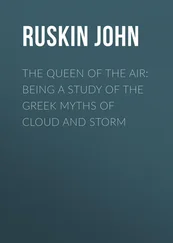George Dodd - The History of the Indian Revolt and of the Expeditions to Persia, China and Japan 1856-7-8
Здесь есть возможность читать онлайн «George Dodd - The History of the Indian Revolt and of the Expeditions to Persia, China and Japan 1856-7-8» — ознакомительный отрывок электронной книги совершенно бесплатно, а после прочтения отрывка купить полную версию. В некоторых случаях можно слушать аудио, скачать через торрент в формате fb2 и присутствует краткое содержание. Жанр: foreign_antique, foreign_prose, на английском языке. Описание произведения, (предисловие) а так же отзывы посетителей доступны на портале библиотеки ЛибКат.
- Название:The History of the Indian Revolt and of the Expeditions to Persia, China and Japan 1856-7-8
- Автор:
- Жанр:
- Год:неизвестен
- ISBN:нет данных
- Рейтинг книги:3 / 5. Голосов: 1
-
Избранное:Добавить в избранное
- Отзывы:
-
Ваша оценка:
- 60
- 1
- 2
- 3
- 4
- 5
The History of the Indian Revolt and of the Expeditions to Persia, China and Japan 1856-7-8: краткое содержание, описание и аннотация
Предлагаем к чтению аннотацию, описание, краткое содержание или предисловие (зависит от того, что написал сам автор книги «The History of the Indian Revolt and of the Expeditions to Persia, China and Japan 1856-7-8»). Если вы не нашли необходимую информацию о книге — напишите в комментариях, мы постараемся отыскать её.
The History of the Indian Revolt and of the Expeditions to Persia, China and Japan 1856-7-8 — читать онлайн ознакомительный отрывок
Ниже представлен текст книги, разбитый по страницам. Система сохранения места последней прочитанной страницы, позволяет с удобством читать онлайн бесплатно книгу «The History of the Indian Revolt and of the Expeditions to Persia, China and Japan 1856-7-8», без необходимости каждый раз заново искать на чём Вы остановились. Поставьте закладку, и сможете в любой момент перейти на страницу, на которой закончили чтение.
Интервал:
Закладка:
It was in the year 1398 that Tamerlane – familiar to all school-boys in England by the famous name of Timour the Tatar – first set foot in India, and laid the foundation of the Mogul dynasty. Properly speaking, he was not a true Mogul, but belonged to the rival Tatar nation of Turcomans; nevertheless the line of emperors to which he gave origin has always been known as the Mogul dynasty. He was a ruthless conqueror, who, having ravaged all Central Asia from the Black Sea to the Chinese frontier, turned his attention towards India. He crossed the Indus at Attock, went to Moultan, and extended his march to Delhi, wading through Hindoo blood, which he shed without resistance and almost without cause. The native annalists record how he put a hundred thousand beings to death in the great city; how he caused himself to be proclaimed Emperor or Great Mogul of India; how he departed suddenly to end his days on the other side of the Indus; and how Delhi mourned for many a year over its miseries. No pen can describe what India suffered during the next century and a quarter, with a Mogul emperor at Delhi, constantly fighting with the Mohammedan chieftains who resisted his authority.
The long but often broken line of wretched despots need not be enumerated here: a few landmarks of great names – Baber, Akbar, Jehanghire, Shahjehan, Aurungzebe, Nadir Shah – will furnish all that is needful for our present purpose.
Baber – or, in more majestic form, Zahireddin Mohammed Baber – a descendant of Tamerlane, was the first really great Mohammedan emperor of Delhi, the first Mogul who regarded his subjects in any other light than as a prey to be spoliated. Centering his power at Delhi, he extended it eastward to the mouth of the Ganges; and although, in his short reign of four years, from 1526 to 1530, constantly engaged in military expeditions, he nevertheless found time to cultivate the arts of peace, and to attend to whatever appeared calculated to promote the prosperity of his empire. In blood-shedding, he was scarcely surpassed by his predecessor Tamerlane: indeed this was a propensity among all the Tatar chieftains of those times. When his warlike and angry passions were not excited, Baber could, however, come forth in a very different light, as a kind and forgiving man, one fond of friends and friendship, and not without a tinge of poetry in his tastes. He was a man of business, who attended personally to the affairs of government, and passed fewer hours in sensual idleness than is customary with oriental princes. With the Hindoos he had little trouble; their national character was by this time much broken; the rapid succession of reigning families had inured them to change; and they had imbibed a feeling of horror and dismay from the atrocities to which the various Moslem conquerors had subjected them. When opposition to his progress had once ceased in India, he became an altered man. He made or improved roads; established serais or resting-places for travellers at suitable distances; caused the land to be measured, in order to fix taxation by equitable adjustment; planted gardens, and introduced many trees and plants until then unknown in India; established a regular post from Agra, through Delhi, Lahore, and Peshawur, to Cabool; and wrought many improvements in the city of Delhi.
Akbar, unquestionably the wisest and greatest prince who ever ruled India – a prince who was really a benefactor to his people – was the grandson of Baber. Becoming emperor of Delhi in 1556, he established the Mogul dynasty on a firmer basis than it had before occupied. The native Hindoos enjoyed, under him, greater prosperity than they had ever experienced since the first invasion of the Mohammedans. He was distinguished by a spirit of toleration and a love of justice; and the memory of his virtues is to this day treasured up by the Hindoos as well as the Mussulmans of India. As the worshippers of Islam had, by the time of Akbar, fallen out much among themselves, in various parts of Asia, the Mogul Moslems of India gradually became weaned from sympathy with the rest, and prepared for more thorough amalgamation with the Hindoos than had ever before been possible. If not an amalgamation by family ties, it was at least an incorporation by civil and social usages; and thus it is that from the time of Akbar may be dated the remarkable mixture of Mohammedans and Hindoos in so many towns of India. Ambitious chieftains might continue to struggle for supremacy; but the populace of the two religions began to wish rather to trade together than to exterminate each other. Akbar had the genius to see the full force of this tendency, and the honesty to encourage it. He never crushed those whom he conquered; but invited all alike, Hindoos as well as Mohammedans, to settle down as peaceful citizens, assured that they would receive equal justice from him regardless of their religious differences. He placed natives of both races in offices of trust; he abolished the capitation-tax on infidels; he forbade the degradation of war-prisoners to the position of slaves; he abrogated such of the Hindoo laws as were most repulsive to reason or humanity, without being vital parts of their religion; he discouraged fanaticism among those of his own faith; he encouraged trade and commerce; he reduced taxation; and he kept a strict watch over the conduct of the officers of his government. The mildness of his character, his strict impartiality to the different classes of his subjects the magnanimity which he shewed to his enemies, and his great personal courage are mentioned with praise even by the Jesuits, who visited India during his reign. Well did this eminent man, during his long reign of forty-nine years, deserve the title of Akbar the Great; and natural was it that his subjects should look up with reverence to Delhi, the centre and seat of his empire. His reign, both in its beginning and its end, was almost exactly contemporaneous with that of Queen Elizabeth in England.
Jehanghire, a far inferior prince to Akbar, succeeded him in 1605, and soon became involved in troubles. The Uzbeks obtained possession of his dominions in Cabool; the King of Persia took Candahar from him; the Afghans revolted from his rule; the Hindoo Rajpoots commenced their struggles for independence; and, at a later date, his son Shahjehan rebelled against him. Nevertheless, Jehanghire, judged by an oriental standard, was not a bad ruler of Hindostan. The country enjoyed considerable prosperity under him; literature was extensively cultivated; many new cities were built; the Hindoo religion experienced even greater toleration than in the reign of Akbar; and he gave a courteous reception to Sir Thomas Roe, sent on an embassy from England to the Great Mogul. He was, however, a strange being. In a fit of anger against certain rebels, he caused several hundreds of them to be impaled, and placed in a row leading out of the Lahore gate at Delhi; and he himself rode past them on an elephant, ‘to receive the obeisance of his friends.’ His native ferocity also shone out, in his causing one of his principal councillors to be sewed up in the hide of a newly flayed ox, and thrown into the street; the hide, shrinking in the heat of the sun, compressed him to death; but as the compression came too soon to satisfy the savage feelings of the monarch, he caused the next victim, when similarly incased, to be sprinkled with water occasionally, to prolong the torture. One of the most remarkable circumstances in the career of Jehanghire was the influence gradually acquired over him by his Sultaness Nurmahal, the ‘light of the palace,’ whose name became changed to Nurjehan, the ‘light of the world;’ her exquisite beauty, wit, and accomplishments, won the love of the monarch; and as she was in mind and heart far his superior, her power over him was often exerted for good purposes.
Shahjehan, an ungrateful son to Jehanghire, was destined to be, in turn, the victim of his own son Aurungzebe. He was an emperor from 1627 to 1659, and then a miserable uncrowned captive for seven years longer. He attacked all the neighbouring princes whose dominions or wealth he coveted; and blinded or murdered all his relations whose ambition he dreaded. And yet, amid his atrocities, he was a man of much ability. Delhi, Agra, and other cities, benefited by his rule. The internal government of his kingdom was very complete. The great mosque at Delhi, and the Taj Mahal at Agra, which rose at his command, are, to this day, objects of admiration to the natives of India. Though it may, to English minds, have been a waste of public money to spend six millions sterling on the far-famed peacock’s throne; yet, as all his establishments were formed on a scale of great magnificence, and as numerous other cities and towns throughout the Empire vied with the splendour of Delhi and Agra – there is evidence that the Mogul and his dominions must have owned vast wealth. He possessed both taste and financial tact; and thus, with all his atrocities, Shahjehan left behind him a full treasury and a splendid and prosperous empire.
Читать дальшеИнтервал:
Закладка:
Похожие книги на «The History of the Indian Revolt and of the Expeditions to Persia, China and Japan 1856-7-8»
Представляем Вашему вниманию похожие книги на «The History of the Indian Revolt and of the Expeditions to Persia, China and Japan 1856-7-8» списком для выбора. Мы отобрали схожую по названию и смыслу литературу в надежде предоставить читателям больше вариантов отыскать новые, интересные, ещё непрочитанные произведения.
Обсуждение, отзывы о книге «The History of the Indian Revolt and of the Expeditions to Persia, China and Japan 1856-7-8» и просто собственные мнения читателей. Оставьте ваши комментарии, напишите, что Вы думаете о произведении, его смысле или главных героях. Укажите что конкретно понравилось, а что нет, и почему Вы так считаете.












